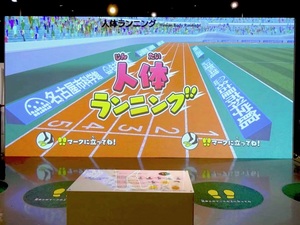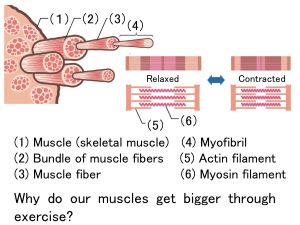Nagoya City Science Museum
TOP > Exhibition Guide > Keyword Search > Starting with "N" > nerve > Human Body Running
Human Body Running



Purpose of Exhibition
An animated image of a stadium is displayed on a big screen. There are four footprint symbols on the floor in front of the screen. When you select one of the symbols and stand on it, an illustration depicting bones, muscles, nerves, or blood vessels in the entire human body will be displayed in front of you. When you move your body (arms), the arms shown in the illustration on the screen will move accordingly.
After the starting signal is given, the illustrated human body on the screen will start running when you start moving your arms.
On the screen, a pacemaker runs in Lane 3, the center lane of the five lanes. You need to adjust the speed of swinging your arms so that the illustrated human body displayed in front of you can run at the same speed of the pacemaker. After reaching the goal, you will be evaluated whether you have run at the same pace as the pacemaker. (Excellent (3 stars★ 3 ): Gold medal, Good Job (2 stars★ 2 ): Silver medal, Nice Try (1 star★ 1): bronze medal)
During the game, four different videos are displayed at the top of the screen to show respectively how the bones, muscles, nerves, and blood vessels operate while running. Moreover, at the back of this exhibit, more information is provided with illustrations on exercises and muscles.
After enjoying this game by moving your body, please look at other exhibits and enjoy more hands-on experiences on this “Wonders of Human Body” floor to think about your body, which continues to operate without even you knowing it.
There are some points to note to fully enjoy this game. Up to four people can participate at one time. Also, only one person should stand on one footprint symbol. The game may not operate properly if there is someone between the players and the screen or near the players. So, the waiting people are requested to stand stay outside the tape barriers located at the left and right sides or stand step back frombehind the footprint symbols.
Meanwhile, the sensor camera may not be able to read your posture or movements accurately depending on the shape and color of your clothes. In such a case, you may not be able to fully enjoy the game.
Additional Knowledge
[ Which part of a human body is the best player? ]
When there are other players participating in the game, you may want to compete with them to see which human body displayed on the screen can run most successfully. Some people may have enjoyed comparing the evaluation results while some others may have felt a little disappointed. In this exhibit, there are only four lanes to run, and the entire process from the point of reception to the goal and evaluation is completed in only less than two minutes. In a real human body, however, many more organs and tissues work together astonishingly effectively all day long. Your body is, so to speak, the best team, comprising members who all work in the right way and win a gold medal every day.
[ How do we master sport skills through practice? ]
When we exercise, each part of our body sends information such as body movements and positions one after another while the central nervous system (brain and spinal cord) consecutively sends commands to move the body. When we practice, some changes will be made in the nerve cells that convey information and commands and also in the way they are connected. This leads to an improved transmission of such information and commands. Furthermore, it is thought that even if we make a wrong movement, we will learn how to fix it immediately and become able to make the right movement.
[ Why do our muscles get bigger through exercise? ]
Muscles comprise bundles of thin threads called muscle fibers.
Furthermore, muscle fibers are a collection of much more thinner threads, myofibrils. There are two types of myofibrils, called actin filaments and myosin filaments.
When a muscle contracts, the two types of myofibrils slide between each other, and when the muscle relaxes, they respectively return to their original positions. It is believed that physical training makes muscles bigger because it helps produce many myofibrils.
Article by Tomoko Horiuchi, curator
This item is preparing.
